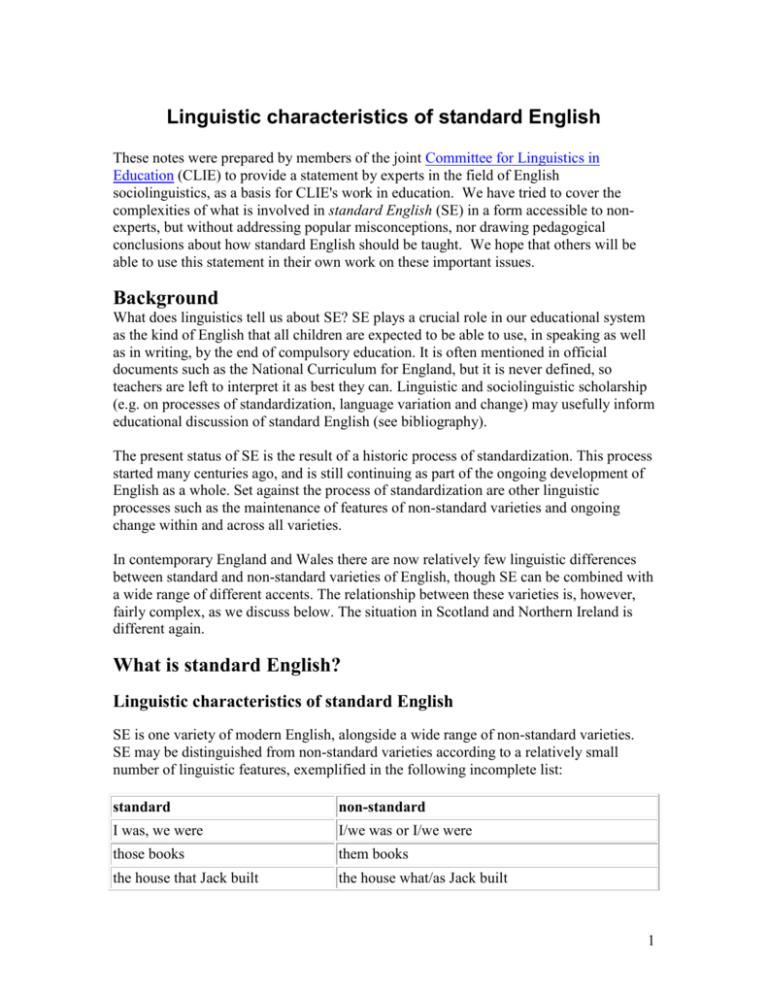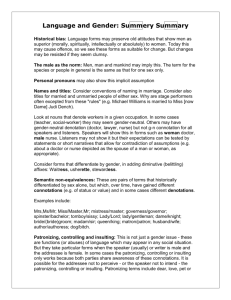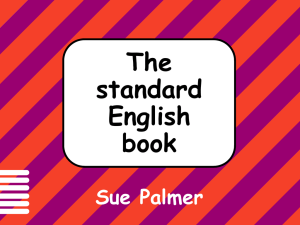What is standard English? - Committee for Linguistics in Education
advertisement

Linguistic characteristics of standard English These notes were prepared by members of the joint Committee for Linguistics in Education (CLIE) to provide a statement by experts in the field of English sociolinguistics, as a basis for CLIE's work in education. We have tried to cover the complexities of what is involved in standard English (SE) in a form accessible to nonexperts, but without addressing popular misconceptions, nor drawing pedagogical conclusions about how standard English should be taught. We hope that others will be able to use this statement in their own work on these important issues. Background What does linguistics tell us about SE? SE plays a crucial role in our educational system as the kind of English that all children are expected to be able to use, in speaking as well as in writing, by the end of compulsory education. It is often mentioned in official documents such as the National Curriculum for England, but it is never defined, so teachers are left to interpret it as best they can. Linguistic and sociolinguistic scholarship (e.g. on processes of standardization, language variation and change) may usefully inform educational discussion of standard English (see bibliography). The present status of SE is the result of a historic process of standardization. This process started many centuries ago, and is still continuing as part of the ongoing development of English as a whole. Set against the process of standardization are other linguistic processes such as the maintenance of features of non-standard varieties and ongoing change within and across all varieties. In contemporary England and Wales there are now relatively few linguistic differences between standard and non-standard varieties of English, though SE can be combined with a wide range of different accents. The relationship between these varieties is, however, fairly complex, as we discuss below. The situation in Scotland and Northern Ireland is different again. What is standard English? Linguistic characteristics of standard English SE is one variety of modern English, alongside a wide range of non-standard varieties. SE may be distinguished from non-standard varieties according to a relatively small number of linguistic features, exemplified in the following incomplete list: standard non-standard I was, we were I/we was or I/we were those books them books the house that Jack built the house what/as Jack built 1 He did it. He done it. He came yesterday. He come yesterday. (and likewise for thirty or so other irregular verbs) Nobody said anything. Nobody said nothing. He ran really quickly. He ran real quick. I didn't break it. I never broke it. He hasn't finished. He ain't finished. Almost all these differences consist of alternative ways of expressing the same meaning, and in almost every case the differences are linguistically trivial and show no communicative advantage either for standard or for non-standard. For example, the sentences He ain't done nothing and He hasn't done anything are different ways of expressing the same meaning, each of which follows a clear set of grammatical principles. It is not the case that non-standard shows worse logic or less care in speaking, any more than this would be true of (say) French. English and French are very different linguistic systems, and similarly, standard and non-standard varieties of English are slightly different linguistic systems. In discussing language variation, it is conventional to distinguish between dialects (varieties that differ in terms of pronunciation, grammar, lexis, semantics) and accents (varieties that differ just in terms of pronunciation). According to this distinction, SE is a dialect that may be spoken in a range of accents, including received pronunciation (RP) and regional accents. A distinction may also be made between standard/nonstandard varieties (based on the social and regional background of speakers) and registers, associated with particular contexts of use (e.g. the language of law, education, casual chat between friends). There is however a relationship between these different dimensions of variation, in that SE is commonly associated with more formal registers such as those of law and education though it also has a range of casual registers like any other dialect. While it is possible to identify some linguistic characteristics of standard and nonstandard varieties of English, as in the list above, the relationship between these varieties is more complex than the list suggests: While some non-standard features are widespread (e.g. Nobody said nothing, He ran real quick), many are local so they vary from place to place (e.g. us for standard our, as in We had us tea, found in Yorkshire, Central and East Lancashire and parts of the East Midlands) Equally important is the regional variation in SE, with small but recognisable differences even between England/Wales and Scotland (e.g. standard Scottish English That mustn’t be true meaning the same as standard English English That may not be true), not to mention the international variation discussed below. Differences within SE also occur because informal SE is different from formal writing (e.g. There's about ten people outside). Equally there are hyper-correct 2 forms such as between you and I, which are hard to classify as either standard or non-standard. Because differences between standard and nonstandard varieties are relatively small, there are also considerable overlaps between varieties. All varieties, including SE, change over time (e.g. the older Have you any children? is giving way to Have you got any children? or Do you have any children?). Individual speakers vary in the way they use language, and may also shift between varieties for stylistic effect. Varieties of language, therefore, do not exist as discrete, fixed, unified entities, and indeed ‘SE’ may be better regarded linguistically as an idealization. Geographical variation in standard and non-standard English In Scotland, a standard variety of English (Scottish Standard English) exists alongside a minority language, Scots. Both Scots and English have similar roots (as Germanic languages), which distinguishes them from Gaelic (a Celtic language). Scots shows some significant differences from Standard English in terms of vocabulary, pronunciation and grammar. Some examples of grammatical differences (taken from the SCOTS corpus, www.scottishcorpus.ac.uk) are presented below: Scots I’m silly, amn’t I? You’ll can enjoy your holiday now Fit wey was that? How do you nae put that ain in your pocket? I nae ken how to put the cord in English I’m silly, aren’t I? You’ll be able to enjoy your holiday now Why was that? Why don’t you put that one in your pocket? I don’t know how to put the cord in Like the differences between Standard and non-standard varieties of English, the differences between Scots and English tend to cluster around particular aspects of grammar, such as negation, question formation, and the use of auxiliary verbs. The spread of English around the world, and contact between speakers of English and other typologically distinct languages, has resulted in the development of a wide variety of 'new Englishes'. Some of these new Englishes have developed standard and vernacular varieties of their own. For instance, in Indian English, there are some significant differences between standard and non-standard wh-question formation and embedded question formation. The standard form is identical to standard British English: What has she read? He was wondering what she has read However, vernacular Indian English uses different structures: What she has read? He was wondering what has she read 3 Contact with other languages may also mean that structural characteristics and lexical items of one language may be transferred into the English spoken in a given area. For instance, it has been suggested that the high degree of contact between English and Chinese in Singapore may be one reason for the prevalence of null-subject sentences in Singapore English, even in fairly formal circumstances. The following example (from Deterding 2007: 58) comes from an interview with a Chinese trainee teacher; the asterisks mark places where UK SE would require an overt subject: so in the end ... * didn't didn't try out the rides, so initially * want to to take the ferris wheel ... but then ... the queue is very long and too expensive, so * didn't, didn't take any ... * spent about two hours there looking at the things Indeed, a fascinating aspect of English in such contact situations concerns the emergence of standard forms which don't correspond to the standard forms of other Englishes: what constitutes the standard is often negotiated at a fairly local level, so there is a range of standard Englishes across the world. Social characteristics of standard and non-standard English SE is often defined socially, rather than linguistically as a ‘language of wider communication’, i.e. a variety which is widely understood and used. This definition suggests a neutral medium that facilitates communication between people from different regional and social backgrounds. However, there is no evidence that it is in fact more widely understood than non-standard varieties, and indeed it is likely that accent is more of a barrier to understanding than dialect. Moreover, SE tends to be spoken at home by members of higher social classes (estimates put the number at not more than 15% of the population in Britain). The association of SE with social class and level of education is inconsistent with ideas of social neutrality and SE is sometimes seen more critically as a class dialect that serves to exclude rather than include other speakers. SE will have a range of associations for speakers – as neutral, educated, a language of social advancement, posh, exclusive, snobby. Such social meanings will affect how SE forms are taken up and used by speakers – something that needs to be taken into account in any attempt to teach SE. Most economically advanced nations have one or more official or national standardized languages which at least some children learn at school and which are used in public and formal situations. In many countries, however, non-standard dialects have much higher social status than in Britain; for instance, in German-speaking Switzerland and in most parts of the Arabic-speaking world everyone uses the local non-standard variety at home so the link to social class is absent. Such evidence shows that standard and non-standard dialects can co-exist in a complementary relation, without being seen as in competition. This ‘bi-dialectism’ is comparable with the bilingualism of many speakers of community languages in Britain. This seems a satisfactory and sustainable outcome, and, in spite of the proscriptive attitudes of previous generations, there is no reason to assume that SE has to replace non-standard varieties. Standard and non-standard English in education 4 SE and education are closely entwined, since education is the main channel for transmitting SE to speakers of other varieties and of teaching formal and written registers to all; and SE is the medium of most lessons and of the formal discourse of education. At one time there was a debate about whether schools should teach SE at all, and in particular about the need to teach spoken SE, but this debate has now been replaced by general agreement that schools should teach both written and spoken SE. (In practice, given the overlaps between varieties mentioned above, this would involve teaching, or drawing attention to, features that distinguish standard and non-standard forms.) CLIE sees no reason to disagree with this view. A similar consensus exists, at least on paper, about responses to non-standard forms. These are no longer described in educational circles as 'wrong' or as 'mistakes', but are recognised as linguistically equivalent to their standard alternatives: official publications contain few negative references to non-standard varieties. Indeed, it would be fair to say that official publications hardly mention non-standard varieties at all (and equally rarely try to define SE). This benign neglect is not enough to give non-standard varieties the status they should have as the varieties used by most school-children. The principle of 'starting where the child is' demands more serious attention, both in policy documents and in the classroom, to the varieties of English that most children know already. The arguments are familiar from the literature on community languages and English as an Additional Language; but they are rarely applied to non-standard varieties. CLIE therefore believes that local non-standard forms should be much more ‘visible’ in the curriculum. As the normal speech of most pupils, they should be the starting point both for learning about SE and for exploring general principles of language – ‘Knowledge About Language’. We urge educationalists to devote more research to the question of how best to realise this principle. Paradoxically, therefore, we end a statement about the teaching of SE by focussing on the importance of teaching about non-standard varieties. References and further reading Deterding, David. 2007. Singapore English. Edinburgh: Edinburgh University Press. Hogg, Richard. 2000. The standardiz/sation of English. Paper presented to the Queen’s English Society. Kerswill, Paul. 2007. Standard and non-standard English. In D. Britain (ed.) Language in the British Isles (2nd edition). Cambridge: Cambridge University Press, 34-51. Trudgill, Peter. 1999. Standard English: What it isn’t. In Tony Bex & Richard J. Watts eds. Standard English: the widening debate. London: Routledge, 1999, 117-128 Williams, Ann. 2007. Non-standard English in education. In D. Britain (ed.) Language in the British Isles (2nd edition). Cambridge: Cambridge University Press, 401-416. 5 Williams, Ann. 2008. Discourses about English: Class, codes and identities in Britain. In Marilyn Martin-Jones et al, (eds.) Encyclopedia of Language and Education (2nd edition) Vol 3: Discourse and Education, Springer, 237-50. 6





